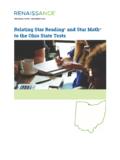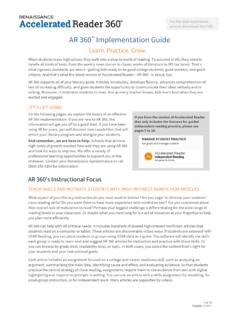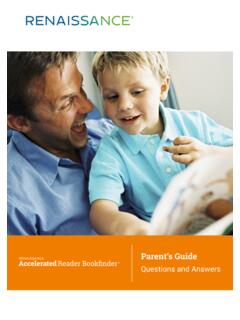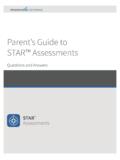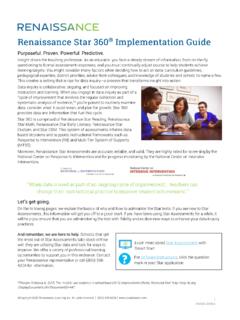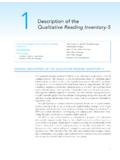Transcription of Guided Independent Reading - doc.renlearn.com
1 TECHNICAL PAPER | NOVEMBER 2012. Guided Independent Reading Accelerated Reader, Accelerated Reader Best Practices, Advanced Technology for Data-Driven Schools, AR, AR Best Practices, ATOS, Renaissance, Renaissance Learning, the Renaissance Learning logo, and STAR Reading are trademarks of Renaissance Learning, Inc., and its subsidiaries, registered, common law, or pending registration in the United States and other countries. 2012 by Renaissance Learning, Inc. All rights reserved. Printed in the United States of America. This publication is protected by and international copyright laws. It is unlawful to duplicate or reproduce any copyrighted material without authorization from the copyright holder. For more information, contact: RENAISSANCE LEARNING. Box 8036. Wisconsin Rapids, WI 54495-8036. (800) 338-4204. 11/12. Contents 1. Accelerated Reader Best Practices: Factors of 3. Research 6. Research Implications and Accelerated Reader Best 12. 16. 17. Figures Figure 1: Example AR Reading Practice Quiz 2.
2 Figure 2: Performance on the ACT Reading Test by Comprehension Level (Averaged Across Seven Forms).. 4. Figure 3: Suggested ZPD Ranges per STAR Reading Grade Equivalent Score .. 5. Figure 4: Students Experience Greatest Reading Growth With Averages Between and 95 8. Figure 5: Gains Leap When Students Are Actively Engaged in Reading at Least 15 to 24 Minutes per 9. Figure 6: Optimal Reading Practice Begins Within ZPD; Successful Comprehension Leads to Higher 12. Figure 7: Example Process for Adjusting ZPDs Based on Reading Practice Quiz Performance .. 15. Tables Table 1: Student and Quiz Frequency by Grade .. 6. Table 2: Sample Size Broken Down by Student Grade and Pretest Achievement Level .. 7. Table 3: STAR Reading Posttest NCE Regressed Onto APC, ERT, and ZPD While Controlling for Pretest NCE .. 7. Table 4: Descriptive Statistics for APC, ERT, and ZPD .. 8. Table 5: STAR Reading NCE Gain Broken Down by APC .. 8. Table 6: STAR Reading NCE Gain Broken Down by ERT.
3 9. Table 7: Quiz Frequency and Performance per Suggested ZPD Range .. 10. Table 8: Multiple Regression Analyses Regressing STAR Reading Posttest NCE Onto Percent Quizzes Passed for Each ZPD Category While Controlling for Pretest NCE, Quizzes Passed, APC, and ERT .. 11. Table 9: STAR Reading NCE Gain as a Function of Suggested ZPD and APC .. 12. i ii Introduction In 2003, company co-founder Terry Paul published the seminal Guided Independent Reading report, which summarized research from a base of Renaissance Learning customers that served to shape the Accelerated Reader (AR) Best Practices. The original report included data from 50,823 students across 24 states, a sizeable sample for the time. Since then, technological advances have allowed Renaissance Learning to offer a service of hosting customer data on company servers, resulting in a more cost-effective customer experience and a product information database of considerable size and scope. In the same spirit of the The current report draws upon initial Paul (2003) manuscript, we have updated the data collected during the 2010.
4 Report using current information and larger sample sizes, to once again evaluate and inform recommendations for 2011 school year and includes Guided Independent Reading . Specifically, the current more than 2 million students report draws upon data collected during the 2010 2011. school year and includes more than 2 million students representing all 50 states and representing all 50 states and the District of Columbia. the District of Columbia. In addition to an updated, larger sample, the new report also takes into account changes in the national landscape concerning educational policies and practices. Since 2003, emphasis has shifted from No Child Left Behind policies and adequate yearly progress measures to college- and career-readiness initiatives such as those outlined in the 2010 Common Core State Standards (CCSS) and other revised state standards. For example, recent initiatives have led to an increased interest in issues related to text complexity, such as how it should be measured and what recommendations should be used for student Reading .
5 Another change is increased emphasis on student growth, as per guidance from the Department of Education in its Elementary and Secondary Education Act (ESEA) waiver program. Schools are under increasing pressure to demonstrate that students are growing sufficiently in their academic abilities. The research and recommendations on the following pages take recent education policies and reforms into consideration as well as present relevant information to help inform decisions about modern classroom practices. Guided Independent Reading Across the board, practice is recognized as an essential Across the board, practice component of any learning process (Willingham, 2009). Similarly, emphasizing the role of practice and hard work is recognized as an (rather than fixed intelligence) in academic accomplishments essential component of is beneficial for both motivation and performance (Mueller &. Dweck, 1998). As it relates to Reading in particular, research any learning process.
6 Indicates that time spent Reading books is the best predictor Willingham, 2009. of overall academic achievement, even more so than socioeconomic status or ethnicity (Kirsch et al., 2002). Reading practice builds vocabulary, fluency, comprehension, writing, and higher order thinking skills ( , Anderson, Wilson, & Filding, 1988; Baker, Simmons, & Kameenui, 1998; Greenfield, 2009; Guthrie, Wigfield, Metsala, &. Cox, 1999; Reitsma, 1988) as well as enhances general abilities such as visual information processing and speech perception (Dehaene et al., 2010; McBride-Chang et al., 2011). Though beneficial in all forms, Reading practice is most effective when Guided that is, when it is coupled with feedback and instructional support tailored to the individual student (Ericsson, Krampe, & Tesch-R mer, 1993; Paul, 2003; Snow, 2002). Thus, educators should provide plenty of opportunities for in-class Reading practice in which they (1) help students identify appropriate books, (2) monitor students' progress, and (3) intervene to provide instruction or adjust goals as needed.
7 1. Accelerated Reader Creating personalized Reading practice of this nature Figure 1: Example AR Reading Practice Quiz Item requires thorough knowledge of student performance. Monitoring every student's Reading practice can quickly become overwhelming without the help of technology, which is one reason why Accelerated Reader has become the nation's most popular supplemental Reading program (Resnick, Sanislo, & Oda, 2010). Accelerated Reader is a technology tool that enables differentiated, data-driven Reading practice, making the essential student practice component of any Reading curriculum more effective. This practice time is personalized to each student's individual level to ensure a high rate of success and is immediately followed by feedback to help educators target instruction. Reading practice that is personalized includes guiding students to books at appropriate levels, closely monitoring their progress, and intervening with appropriate instruction when necessary.
8 Within Accelerated Reader, four types of computerized quizzes are available. Reading Practice Quizzes form the cornerstone of Accelerated Reader, and are quick and effective means of assessing literal comprehension. Consisting of 5, 10, or 20 multiple-choice questions, and available for more than 140,000. books, they are the most commonly used type of quiz (see quiz item example, Figure 1). Variations on Reading Practice Quizzes are available to help teachers monitor Reading comprehension for students with different abilities. Recorded Voice Quizzes can be used with preliterate, struggling, and emergent readers, and Spanish Quizzes are available for use with Spanish bilingual, English language learner (ELL), and Spanish language learning students. As a supplement to Reading Practice Quizzes, Vocabulary Practice Quizzes are also available to test knowledge of key vocabulary words students encounter during The research evidence on Independent Reading . In addition, Other Reading Quizzes can be used to assess comprehension for textbook Accelerated Reader includes material, and Literacy Skill Quizzes measure higher order experimental and quasi- Reading skills.
9 Experimental studies published A growing collection of research indicates that in peer-reviewed journals. Accelerated Reader is a highly effective program. The research evidence on Accelerated Reader includes experimental and quasi-experimental studies published in peer-reviewed journals. The sizable body of research on Accelerated Reader has contributed to favorable reviews by external panels such as the Florida Center for Reading Research, the National Center on Student Progress Monitoring, and the National Dropout Prevention Center. Renaissance Learning (2012a). has published a summary of key studies supporting Accelerated Reader and more than 150 additional research pieces are available on Renaissance Learning's website ( ). Using Accelerated Reader for Guided Independent Reading involves three basic steps. First, students read books that match their unique achievement levels and interests. Then, students take Reading Practice Quizzes to determine whether they understood what they read.
10 Finally, both students and teachers receive immediate feedback about students' Reading practice. Accelerated Reader automatically scores each quiz and generates reports with straight-forward, comprehensive data summaries to help guide students to appropriate books, monitor Reading practice, and target instruction. 2. This type of performance feedback encourages an academic self-awareness that is important in effective learning and goal pursuit. Positive feedback in particular is thought to foster feelings of competence, enhance intrinsic motivation, and improve performance (Deci & Ryan, 1985; Harackiewicz, 1979). Similarly, research suggests the anticipation of quicker feedback leads to better performance (Kettle & H ubl, 2010). Accelerated Reader Best Practices: Factors of Interest In using Accelerated Reader reports to guide Independent Reading , educators are encouraged to focus on three main factors related to Reading practice: comprehension (quality), time spent Reading (quantity), and the level of challenge presented by the text (difficulty).

